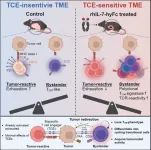(Press-News.org) EMBARGOED by JAMA Network Open until 11 a.m., ET May 31, 2024
Contact: Maria Ober, mpober@bu.edu
BU Study Finds Policy Makers’ Use of In-Hospital Mortality as a Sepsis Quality Metric May Unfairly Penalize Safety-net Hospitals
(Boston)—Sepsis is a leading cause of death and disability and a key target of state and federal quality measures for hospitals. In-hospital mortality of patients with sepsis is frequently measured for benchmarking, both by researchers and policymakers. For example, in New York, sepsis regulations mandate reporting of risk-adjusted in-hospital mortality, and hospitals with lower or higher than expected in-hospital mortality rates are publicly identified as high or low performers. Safety net hospitals (which face unique challenges, including fewer resources to care for a disproportionately high share of underinsured and high-risk patients) have been reported in prior studies to have higher risk-adjusted in-hospital mortality among patients with sepsis than non-safety-net hospitals.
However, among critically ill patients, in-hospital mortality may not adequately reflect short-term mortality fairly across all hospitals. In-hospital mortality is influenced by other variables, including hospital transfer practices, which shift the attribution of short-term death from the hospital to other sites. Safety-net hospitals may have different access or ability to transfer patients compared to non-safety-net hospitals.
In a new study, researchers at Boston University Chobanian & Avedisian School of Medicine found that safety net hospitals do have higher in-hospital mortality than non-safety net hospitals, but their 30-day mortality – an unbiased measure of short-term mortality – is actually not different.
“While the differences in mortality rates are numerically small, the difference in outcome metrics is enough to significantly affect hospital rankings. Current or future state and federal quality measures that use in-hospital mortality as a quality metric may unfairly penalize safety-net hospitals,” explained corresponding author Anica Law, MD, MS, assistant professor of medicine at the school.
The researchers performed a retrospective analysis of patients with sepsis who were aged 66 and older and were admitted to an intensive care unit between January 1, 2011, through December 31, 2019, at both safety and non-safety net hospitals.
“Although in-hospital mortality is often selected as an outcome measure because of its availability in claims databases and hospital medical records without need for post-hospitalization follow-up, the 30-day measure is important to accurately understand true short-term mortality rates,” said Law, who also is a pulmonologist and critical care physician at Boston Medical Center.
According to the researchers, the difference appears to be due partly to the fact that non-safety net hospitals discharge more patients to hospice, which shifts attribution of short-term mortality away from the index hospitalization. “When post-hospitalization data is incorporated, as is done in 30-day mortality analysis, you get a more accurate picture of who is actually dying in the short-term, and see that there no longer a difference between safety and non-safety net hospitals.” The Centers for Medicare and Medicaid Services (CMS) has already legislated a process measure that assesses whether hospitals are performing key sepsis care steps efficiently, including initiating antibiotics. CMS is currently considering rolling out a national sepsis outcome measure; it is not yet known if CMS will be measuring in-hospital mortality or 30-day mortality.
These findings appear online in JAMA Network Open.
Funding for this study was provided by the National Institute of Health (NIH)/National Heart, Lung, and Blood Institute (NHLBI) K23HL153482, National Center for Advancing Translational Sciences (NCATS) 1KL2TR001411, the Doris Duke Charitable Foundation, the Boston University Evans Junior Faculty Merit Award, and the Boston University Chobanian & Avedisian School of Medicine Department of Medicine Career Investment Award.
END
BU study finds policy makers’ use of in-hospital mortality as a sepsis quality metric may unfairly penalize safety-net hospitals
2024-05-31
ELSE PRESS RELEASES FROM THIS DATE:
Mediterranean diet tied to one-fifth lower risk of death in women
2024-05-31
Investigators from Brigham and Women’s Hospital identified and assessed underlying mechanisms that may explain the Mediterranean diet’s 23 percent reduction in all-cause mortality risk for American women
The health benefits of the Mediterranean diet have been reported in multiple studies, but there is limited long-term data of its effects in U.S. women and little understanding about why the diet may reduce risk of death. In a new study that followed more than 25,000 initially healthy U.S. women for up ...
Relieving a fear of public speaking
2024-05-31
By Alistair Jones
SMU Office of Research - If you dread public speaking you are not alone. It is a leading social phobia, one that can cause a state of anxiety that reduces otherwise articulate people to nervous incoherence.
A strong fear of public speaking is known as glossophobia. Academic studies estimate it affects 20 per cent of the population, but depending on the sample and methodology, the figure could be as high as 40 per cent.
As American writer and humourist Mark Twain said, ...
Innovating learning with ChatGPT-based Prompt Tutor
2024-05-31
By Jovina Ang
SMU Office of Research – “Giving students immediate and frequent feedback makes online learning more effective,” Associate Professor Ouh Eng Lieh told the Office of Research.
However, based on how most online lessons are designed, questions could not be answered nor doubts clarified until students meet their instructor in the following face-to-face class.
The time delay of a few days to a few weeks can impede student learning as it might make it difficult for students to catch up and understand the subsequent topics in the course.
Learning also ...
Moving beyond cubicles: How an active workplace design can drive workers’ behaviors
2024-05-31
Ishikawa, Japan -- Physical inactivity and sitting for prolonged hours are highly prevalent among office-based workers, known to be resulting in various health risks and economic constraints. However, to reduce sedentary time and increase physical activity, health promotion interventions alone are insufficient. The design of workplaces should also be considered to promote interactive behavior among workers.
Many models, such as the socio-ecological model, show how multiple factors interact to influence workers' active and sedentary behaviors. These models specifically magnify the impact of workplace environments in shaping these behaviors. Several studies ...
Breakthrough in using bispecific antibodies for solid tumors
2024-05-31
Professor Seung-Woo Lee and PhD candidate Kun-Joo Lee from the Department of Life Sciences at Pohang University of Science and Technology (POSTECH), in collaboration with NeoImmuneTech Director Donghoon Choi and Professors Dae Hee Kim and Sun Shim Choi from Kangwon National University, have revealed a groundbreaking method to significantly enhance the efficacy of bispecific antibody therapies in treating solid tumors. Their findings were published on May 13 in “Cell Reports Medicine”, an international journal of healthcare research.
Bispecific antibodies, which can simultaneously bind to two different ...
Fjords are effective carbon traps regardless of oxygen levels
2024-05-31
The fjords on Sweden’s west coast act as effective carbon traps regardless of whether the bottom water is oxygen-rich or not. This is the conclusion of a new study with researchers from the University of Gothenburg.
Large quantities of plant parts sink to the bottom of fjords on the Swedish west coast where they form sediment. This buries organic carbon, which would otherwise contribute to ocean acidification and the greenhouse effect. When the plant parts are exposed to oxygen and other substances, the organic carbon begins to decompose into inorganic carbon, which can be dissolved into carbonic acid in the water. Research ...
Korea University College of Medicine’s team predict hearing conditions in vestibular schwannoma patients using radiomics
2024-05-31
Korea University College of Medicine’s Team Predict Hearing Conditions in Vestibular Schwannoma Patients Using Radiomics
A recent study demonstrates that radiomics imaging analysis can effectively forecast the hearing status of patients with vestibular schwannoma patients. Since treatment methods, such as surgery or active surveillance, vary for these patients based on tumor size and hearing condition, predicting hearing status is crucial in planning and determining the appropriate treatment.
The research team led by Professor June Choi from the Department ...
European Academy of Sciences honors Rice’s Pol Spanos with prestigious award
2024-05-31
HOUSTON – (May 31, 2024) – For his “exceptional contributions to the field of dynamics,” Pol Spanos, the Lewis B. Ryon Professor of Mechanical and Civil Engineering at Rice University, has been awarded the 2024 Blaise Pascal Medal in Engineering by the European Academy of Sciences.
Spanos, who joined the Rice faculty in 1984, was recognized for his “theoretical insights, ranging from equivalent linearization to statistical quadratization, which have significantly advanced our understanding of structural behavior. These insights have not only led to more accurate predictions but have also empowered engineers ...
Rice’s Jamie Padgett wins Charles Martin Duke Lifeline Earthquake Engineering Award
2024-05-31
HOUSTON – (May 31, 2024) – Jamie Padgett, the Stanley C. Moore Professor in Engineering and chair of civil and environmental engineering at Rice University, has received the 2024 Charles Martin Duke Lifeline Earthquake Engineering Award from the American Society of Civil Engineers (ASCE).
Padgett was recognized for her “contributions to fragility, risk and resilience modeling of multimodal transportation systems and their infrastructure components when subjected to earthquakes and other hazards.”
Her ...
Sleep moderates the link between bullying and suicide in teens
2024-05-31
DARIEN, IL – A new study to be presented at the SLEEP 2024 annual meeting found that sleep duration significantly moderates the association between bullying and suicide attempts among adolescents in the U.S.
The study revealed that 15% of adolescents reported they were bullied at school, and 16% were bullied electronically; 10.2% reported they had attempted suicide during the past year; and 77.3% did not adhere to sleep duration recommendations. Adolescents who reported 4 hours of sleep or less per night were two times as likely to attempt suicide, and sleep duration significantly moderated the association between bullying ...






